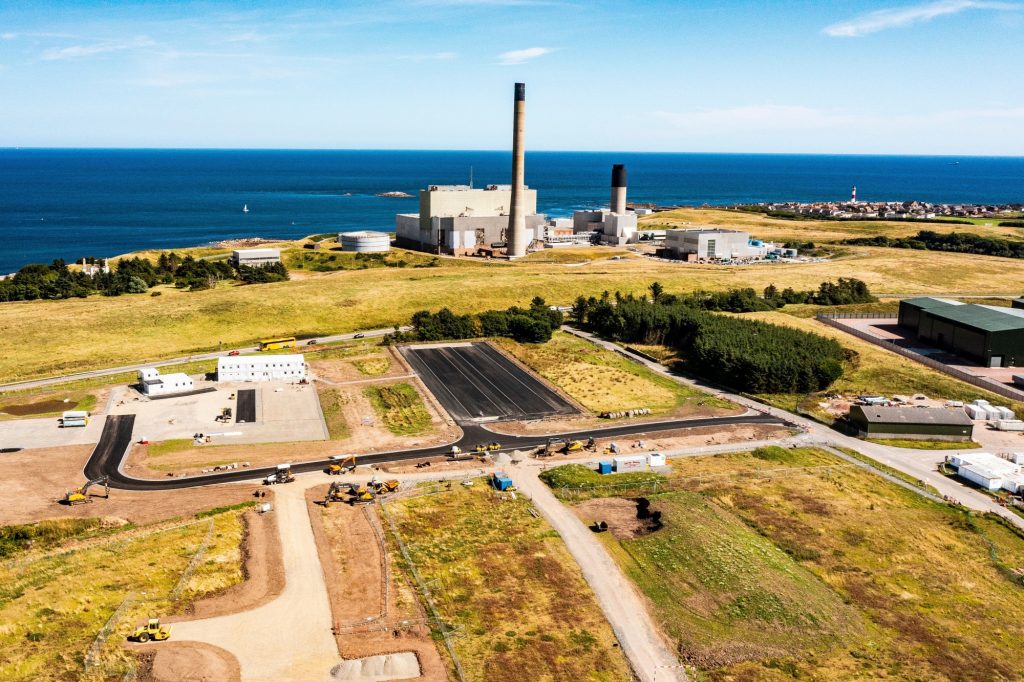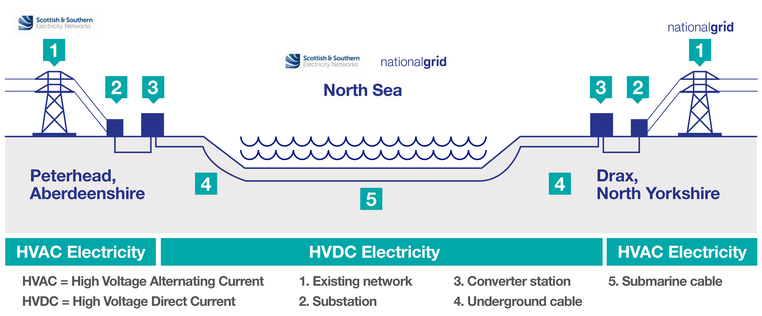Largest ever investment in GB transmission as Ofgem approves £3.4bn England-Scotland offshore link

This post was originally published on this site

Ofgem has approved £3.4bn of public funding for the England to Scotland offshore HVDC link, Eastern Green Link 2 (EGL2), the UK’s single largest electricity transmission project ever.
The project will be delivered for SSEN Transmission and National Grid as a joint venture. It is described as an “electricity superhighway” by Ofgem. It is part of SSEN’s £20bn Pathway to 2030 programme and National Grid’s The Great Grid Upgrade which includes 17 major infrastructure projects.
EGL2 includes 506km of cable running between Peterhead in Aberdeenshire and Drax in North Yorkshire, with 436km under the North Sea and 70km buried underground onshore. Four converter stations, two at each end, will need to be built to feed electricity transported by the cable into the grid and into consumers.
The cable will be 525kV and 2GW, which SSEN Transmission and National Grid said would provide “enough electricity to power 2M homes”.
Prysmian Group will supply 1,000km of cable and Bam Hitachi Energy JV will supply two converter stations at each end of EGL2.
EGL2 is the first of the 26 projects being funded under the Accelerated Strategic Transmission Investment (Asti) framework run by Ofgem to secure funding. Asti accelerates the funding process by up two years.
The need for the cable arose because of increased supply of low-carbon electricity from Scottish offshore wind farms having been delivered in a relatively short space of time, combined with growing demand for decarbonised electricity in the southeast of England.
Demand has grown for decarbonised electricity due to trends such as the expanded use of electric vehicles and the electrification of the railways.
Ofgem said: “Asti projects will not only help provide millions of consumers with access to homegrown wind energy, but by boosting grid capacity they will deliver an estimated £1.5bn of savings by reducing the need to compensate generators who are currently asked to turn off production, during times of high wind, due to lack of grid capacity.
“The projects delivered via Ofgem’s Asti programme are a vital part of the work to upgrade the energy system and allow more renewable energy to be brought onto the grid.
“This will help to deliver the government’s goal of clean power by 2030 and reduce our reliance on volatile international gas markets.”
The Russian invasion of Ukraine and Western Europe’s support for Ukraine led the Russian government to restrict its gas supplies, leading to price increases on the international gas market and high general inflation.
Ofgem said it had approved £3.4bn of funding for the project but the SSEN/National Grid JV said the funding represented £4.3bn of investment. According to the JV, this is because the “nominal investment figure of £3.4bn” was based on 2018/19 prices, which is the base for the price control, and adjusted for inflation it equates to £4.3bn.
In its announcement, Ofgem said that as part of its mission to upgrade the energy system at least possible cost to customers, it had scrutinised the developers’ proposal and identified over £79M of savings which have been cut from the project costs without impacting delivery or quality.
The £79M of savings covers removal of £848,423 “for erroneously submitted consultancy costs”, the removal of £67.2M “for Asti overheads”, and the removal of £11.5M for “low probability risk costs”.
An Ofgem spokesperson told NCE: “We’ve had to build in additional funding allowance for direct and indirect costs which section three [of the decision notice] covers. But we will reopen approval to deal with foreseen uncertainties which can’t be estimated like currency hedging.
“To add, the original basic needs case for EGL2 was £2.1bn in 2018/19 price base but we have accepted the JV partners £3.4bn bid based on increased costs across the board – aside from the £79M of indirect costs.”
EGL2 project director Ricky Saez said: “Ofgem’s decision to issue its final project assessment decision is a major milestone and a testament to the hard work of our project teams within SSEN Transmission and NGET in getting us to the stage where construction can begin later this year.
“We’re also delighted that Aberdeenshire Council has granted approval for our HVDC (high-voltage direct current) converter station near Peterhead, and we’d like to thank the council for their efficient handling of our applications and for their recognition of the importance of the project which will support hundreds of skilled jobs during the construction phase and thousands more across the wider economy.
The Peterhead converter station, which is near Boddam, a village 4.8km south of Peterhead, is due to have construction started later in 2024, according to the JV.
“Not only will EGL2 will play a major role in bolstering energy security and contributing to net zero targets, it will also provide a lasting legacy in local communities where our teams are already supporting local environmental initiatives that enhance community wellbeing.
“This is a commitment that will continue throughout the lifetime of the project and beyond, as we aim to be a positive force in the communities we operate.”
SSEN Transmission director of offshore delivery Sandy Mactaggart said: “With HVDC technology set to play a leading role in the energy transition, the delivery of EGL2 will build on our significant expertise demonstrated through the success of our Caithness-Moray HVDC link, and the ongoing delivery of our Shetland HVDC link.
“We now look forward to working with our partners in NGET on the construction and delivery of this important project, and on future projects including the proposed Eastern Green Link 3 where work is already underway to secure the supply chain.”
National Grid offshore delivery director Zac Richardson said: “Ofgem’s funding decision is a major milestone for EGL2, the single largest-ever investment in a UK electricity transmission infrastructure project.
“We now look forward to delivering supply chain contracts, jobs, and skills, and helping to fulfil the government’s ambition for the UK to be a clean energy superpower.”
“Clean energy superpower” is a phrase used by the new Energy Secretary Ed Miliband to describe the policies he has said he will implement to accelerate the transition to net zero.
Ofgem CEO Jonathan Brearley said: “Ofgem is fully committed to supporting the government to meet its aims of getting clean power by 2030. Today’s announcement is a further step in putting the regulatory systems and processes in place to speed up network regulation to achieve its aim.
“Accelerated Strategic Transmission Investment (Asti) accelerates approval times for projects such as Eastern Green Link 2 (EGL2) by up to two years.
“However, streamlining the process does not mean blank cheques for developers as we are able to step in and make financial adjustments to maximise efficiency and consumer benefit.”
NCE has also recently spoken to National Grid president for UK strategic infrastructure Carl Trowell about how new government policies will aid the energy transition and the Great Grid Upgrade.
Like what you’ve read? To receive New Civil Engineer’s daily and weekly newsletters click here.





Responses